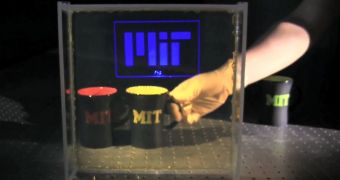A group of researchers at the Massachusetts Institute of Technology (MIT) in Cambridge, led by professors Marin Soljačić and John Joannopoulos, announces the development of a new type of transparent display, which could soon enable the development of advanced head-up displays (HUD).
The new capability is obtained by embedding nanoparticles in a transparent polymer, or plastic. These particles are better suited at reflecting light hitting them at certain wavelengths, meaning that they can, for example, be made to reflect the color blue, as seen above.
All other wavelengths would pass through the display unhindered, without reflecting off the nanoparticles. The team admits that the system is very simple at this point, and in its earliest stages, but says that early results are very encouraging, and adds that further development could lead to transparent displays capable of using more colors without detracting from what you can see through them.
“This is a very clever idea using the spectrally selective scattering properties of nanoparticles to create a transparent display. I think it is a beautiful demonstration,” comments Stanford University professor of electrical engineering Shanhui Fan, who was not involved with this research.

 14 DAY TRIAL //
14 DAY TRIAL //